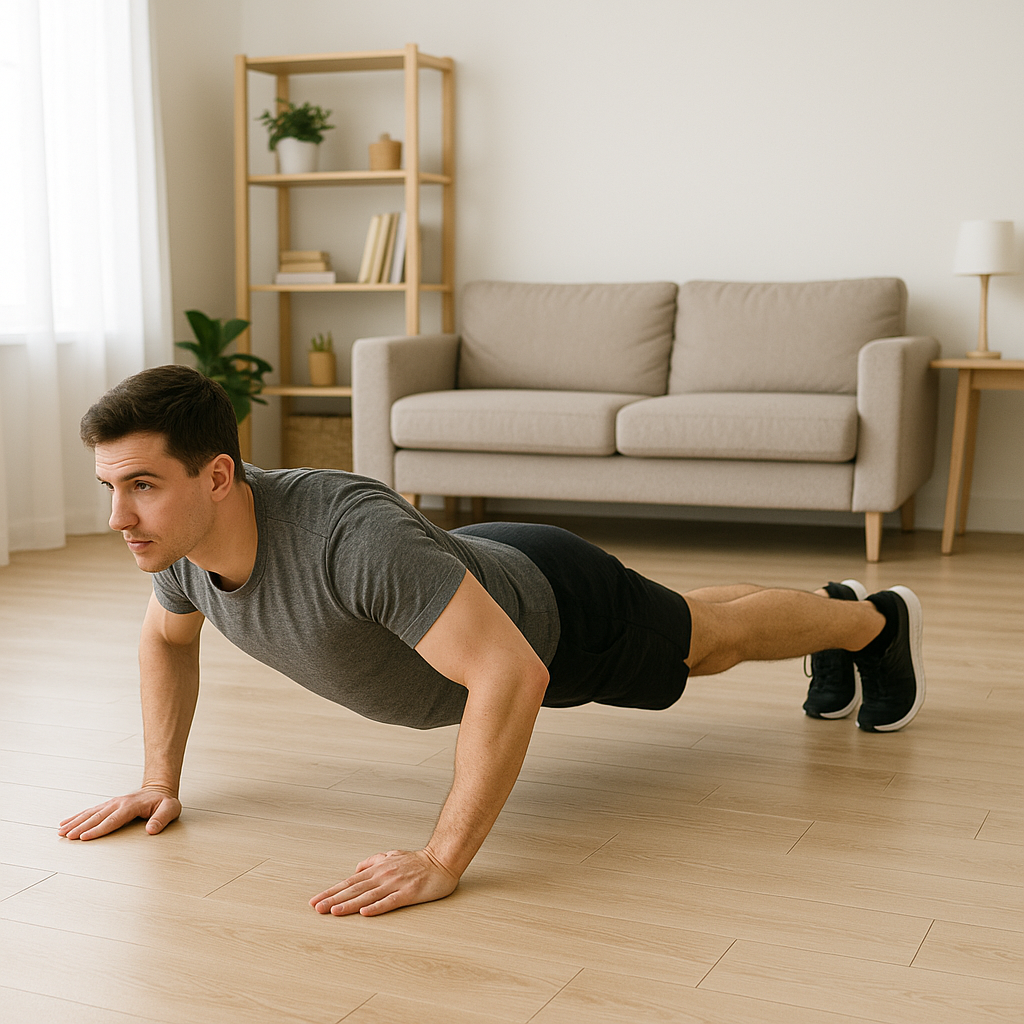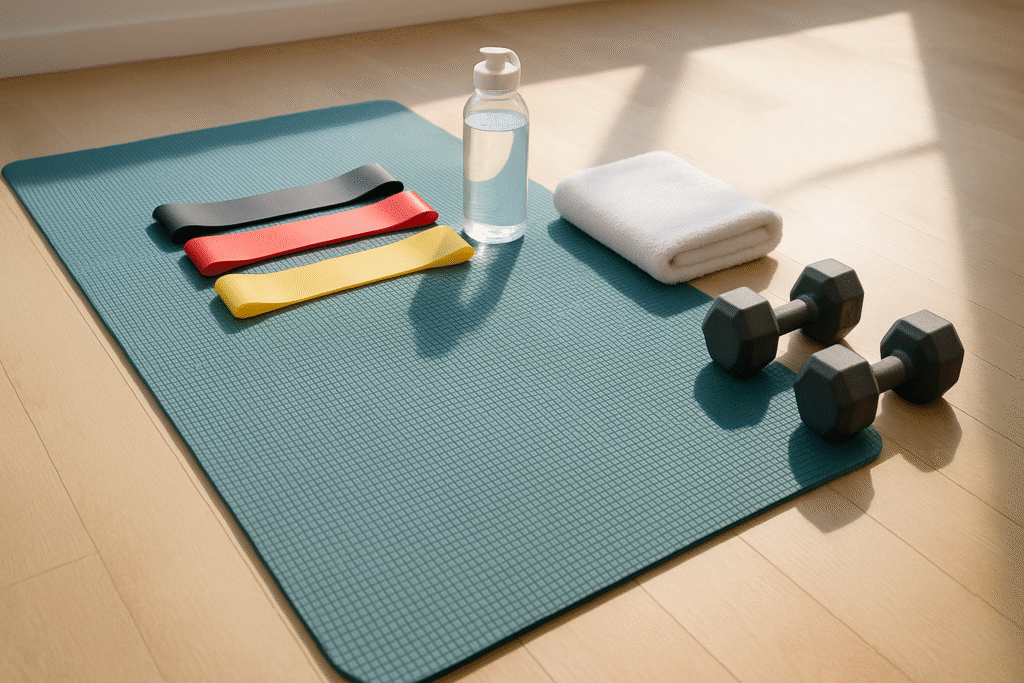Introduction
Starting your fitness journey can feel overwhelming, especially when gym memberships are expensive and time is limited. Home workouts offer the perfect solution for beginners who want to build strength, lose weight, and improve their health without leaving their living room. Whether you’re completely new to exercise or returning after a long break, this comprehensive guide will teach you everything you need to know about effective home workouts.
The beauty of home fitness lies in its accessibility and convenience. You can exercise on your schedule, wear whatever makes you comfortable, and progress at your own pace without feeling judged. Studies show that people who work out at home are 73% more likely to stick to their routine compared to traditional gym-goers. This guide will help you create a sustainable home workout routine that fits your lifestyle, budget, and fitness goals.
Why Home Workouts Are Perfect for Beginners

Home workouts eliminate the most common barriers that prevent people from starting their fitness journey. The intimidation factor of crowded gyms disappears when you’re exercising in your own space. You don’t need to worry about proper gym etiquette, waiting for equipment, or feeling self-conscious about your form. This comfortable environment allows beginners to focus entirely on learning proper movement patterns and building confidence.
Cost-effectiveness is another major advantage. A gym membership in major Indian cities can cost ₹2,000-8,000 monthly, while effective home workouts require minimal equipment investment. You can achieve excellent results with just your body weight and a few basic tools. Time efficiency also makes home workouts ideal for busy professionals. Without commute time to the gym, you can complete a full workout in 30-45 minutes.
The flexibility to pause, rewind, or repeat exercises ensures you master proper form before progressing. Online resources, including BSUN Ventures’ comprehensive workout guides, provide professional instruction at your fingertips. You can also customize your environment – control the temperature, play your favorite music, and even exercise with family members or pets nearby.
Essential Equipment for Getting Started
Contrary to popular belief, you don’t need expensive equipment to start home workouts effectively. Your body weight provides substantial resistance for building strength and endurance, especially for beginners. However, a few strategic equipment purchases can significantly expand your exercise options and provide progressive overload as you get stronger.
Bodyweight Basics (₹0 investment): Push-ups, squats, lunges, planks, and burpees form the foundation of any home workout program. These compound movements work multiple muscle groups simultaneously, providing excellent cardiovascular and strength benefits. A yoga mat (₹500-1,500) provides comfort and stability for floor exercises while protecting your joints.
Resistance Tools (₹1,000-3,000): Resistance bands offer variable resistance and take up minimal storage space. A set of loop bands and tube bands with handles can replicate most gym machines. Adjustable dumbbells, like the Symactive PVC 20kg set available at BSUN Ventures, provide progressive resistance for upper and lower body exercises. These versatile tools grow with your strength level.

Cardio Enhancement (₹500-2,000): A jump rope provides excellent cardiovascular training in minimal space. Step platforms or even your staircase can be used for step-ups and elevated exercises. Suspension trainers offer advanced bodyweight training options but aren’t necessary for beginners.
Technology Support: Fitness apps, YouTube channels, and structured programs like BSUN Ventures’ StartFit84 series provide professional guidance. A smartphone or tablet is often all you need to access world-class instruction and workout tracking.
8 Fundamental Exercises Every Beginner Should Master
Mastering these eight fundamental movements creates the foundation for all future fitness progress. Each exercise teaches essential movement patterns while building functional strength that translates to daily activities.
Upper Body Exercises
Push-ups are the ultimate upper body compound exercise. They strengthen chest, shoulders, triceps, and core simultaneously. Begin with incline push-ups using a couch or wall, progressing to knee push-ups, then full push-ups. Focus on maintaining a straight line from head to heels and controlling both the lowering and pushing phases.
Pike push-ups target shoulders specifically. Start in a downward dog yoga position and bend elbows to lower your head toward the floor. This exercise prepares you for eventual handstand push-ups and builds impressive shoulder strength.
Tricep dips using a chair or couch edge isolate the back of your arms. Keep your back close to the surface and lower until elbows reach 90 degrees. These complement push-ups perfectly for balanced arm development.
Lower Body Exercises
Squats are the king of lower body exercises. Stand with feet shoulder-width apart, push hips back as if sitting in a chair, and descend until thighs are parallel to the floor. Drive through your heels to return to standing. Squats build quadriceps, hamstrings, glutes, and core strength while improving mobility.
Lunges challenge single-leg stability while building functional leg strength. Step forward into a lunge position, lower until both knees form 90-degree angles, then push back to starting position. Alternate legs or complete all reps on one side before switching.
Glute bridges specifically target your posterior chain. Lie on your back with knees bent, squeeze glutes, and lift hips until your body forms a straight line. This exercise counteracts the effects of prolonged sitting and builds essential hip strength.
Core Exercises
Planks build isometric core strength and stability. Start in a push-up position but hold the position rather than moving. Begin with 20-30 second holds and gradually increase duration. Proper form is crucial – maintain a straight line from head to heels.
Mountain climbers combine core strengthening with cardiovascular conditioning. From a plank position, alternate bringing knees toward chest in a running motion. This dynamic exercise elevates heart rate while challenging core stability.
Creating Your First Workout Routine
Structure is essential for consistent progress and avoiding overuse injuries. A well-designed beginner routine balances different movement patterns, allows adequate recovery, and progressively increases difficulty over time.
Frequency and Schedule: Begin with 3 workouts per week on non-consecutive days (Monday, Wednesday, Friday). This schedule provides optimal recovery time while establishing a consistent routine. Each workout should last 20-30 minutes initially, gradually increasing to 45 minutes as fitness improves.
Workout Structure: Each session should include a 5-minute warm-up, 15-25 minutes of strength exercises, and a 5-minute cool-down. Warm-up with light movements like arm circles, leg swings, and marching in place. Cool down with static stretching focusing on worked muscles.
Progression Strategy: Start with 2 sets of 8-12 repetitions for strength exercises. When you can complete all reps with perfect form, increase to 3 sets. Once 3 sets become manageable, add more challenging exercise variations or increase repetitions. For planks and other holds, begin with 20-30 seconds and add 5-10 seconds weekly.
Sample Beginner Routine: Day 1 – Upper body focus (push-ups, pike push-ups, tricep dips, planks). Day 2 – Lower body focus (squats, lunges, glute bridges, mountain climbers). Day 3 – Full body circuit combining all movements. This rotation ensures balanced development while allowing muscle groups to recover.
Common Mistakes to Avoid
Beginners often make predictable mistakes that can lead to injury, frustration, or lack of progress. Understanding these pitfalls helps you avoid them and accelerate your fitness journey.
Skipping warm-up and cool-down is the most common mistake. Cold muscles are more prone to injury, and proper warm-up prepares your body for exercise demands. Similarly, cooling down helps prevent muscle stiffness and promotes recovery.
Progressing too quickly leads to overuse injuries and burnout. Your enthusiasm might tempt you to do advanced exercises or long workouts immediately, but your body needs time to adapt. Stick to the progression plan and trust the process.
Neglecting form for quantity is counterproductive and dangerous. Five perfect push-ups are infinitely better than twenty sloppy ones. Poor form reduces exercise effectiveness and increases injury risk. Always prioritize quality over quantity.
Inconsistent scheduling prevents habit formation and progress. It’s better to do 20 minutes consistently three times per week than to do sporadic hour-long sessions. Consistency builds momentum and creates lasting behavior change.
Frequently Asked Questions
How long before I see results? Most beginners notice increased energy and improved mood within 1-2 weeks. Strength gains become apparent in 3-4 weeks, while visible physical changes typically occur after 6-8 weeks of consistent training.
What if I can’t do regular push-ups? Start with wall push-ups, progress to incline push-ups using a couch, then try knee push-ups before attempting full push-ups. Every fitness journey starts somewhere, and modifications ensure continuous progress.
How do I stay motivated without a gym environment? Set specific, measurable goals, track your progress, and reward achievements. Consider working out with family members or joining online fitness communities for accountability and support.
Should I do cardio and strength training on the same day? For beginners, combining both in the same session is perfectly fine and time-efficient. As you advance, you might choose to separate them, but initially, full-body workouts serve you well.
What should I do if I feel sore after workouts? Mild muscle soreness is normal and indicates your muscles are adapting. Stay active with light movement, stay hydrated, and ensure adequate sleep. Severe pain or joint discomfort warrants medical consultation.
Conclusion
Home workouts offer an accessible, convenient, and effective path to improved fitness and health. By starting with these fundamental exercises and following a structured progression plan, you’ll build strength, confidence, and lasting healthy habits. Remember that consistency trumps perfection – show up regularly, focus on proper form, and trust the process. Your fitness journey begins with that first workout, so clear some space and get started today.
Contact: BSUN Ventures
Website: www.bsunventures.com
Email: Contactbsun@yahoo.com
Address: 148, Netaji Subhash Market, Karol Bagh New Delhi-05
Remember: Always consult with a healthcare professional before starting any new exercise program.
